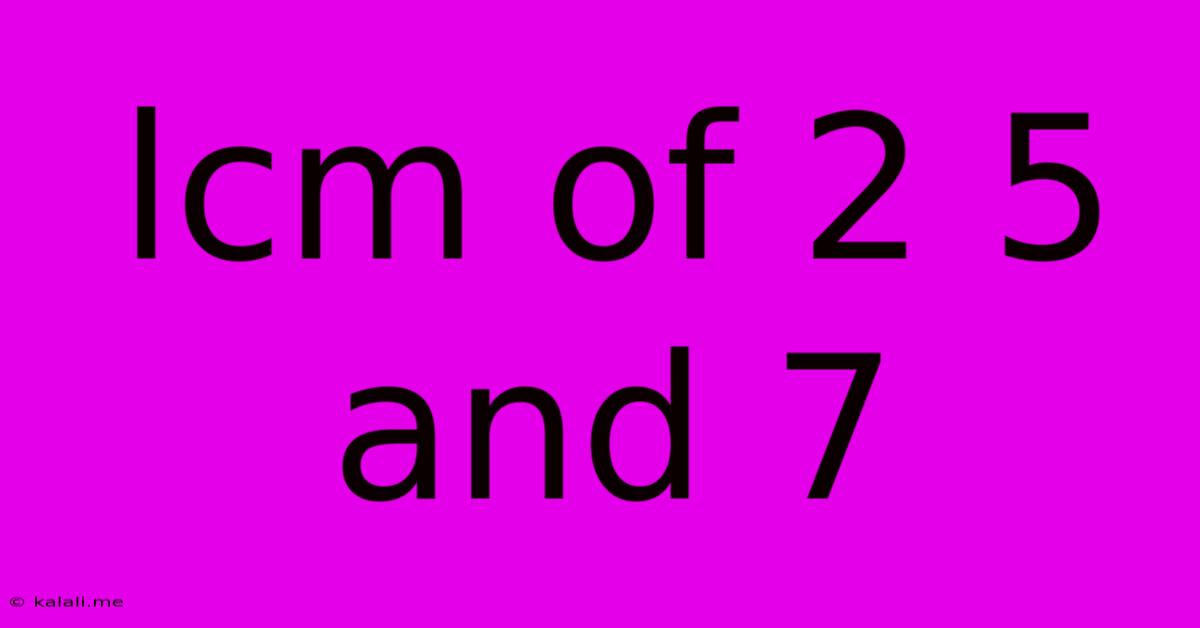Lcm Of 2 5 And 7
Kalali
Jun 13, 2025 · 2 min read

Table of Contents
Finding the Least Common Multiple (LCM) of 2, 5, and 7
Finding the least common multiple (LCM) is a fundamental concept in mathematics, particularly useful in simplifying fractions and solving problems involving ratios and proportions. This article will guide you through calculating the LCM of 2, 5, and 7, explaining the process and providing some helpful context. Understanding LCM is crucial for various mathematical applications, including algebra and number theory.
What is the Least Common Multiple (LCM)?
The least common multiple (LCM) of two or more integers is the smallest positive integer that is divisible by all the integers. In simpler terms, it's the smallest number that all the given numbers can divide into without leaving a remainder. For example, the LCM of 2 and 3 is 6 because 6 is the smallest number divisible by both 2 and 3.
Methods for Finding the LCM
There are several ways to determine the LCM, and we'll explore two common methods:
1. Listing Multiples Method
This method involves listing the multiples of each number until you find the smallest multiple common to all.
- Multiples of 2: 2, 4, 6, 8, 10, 12, 14, 16, 18, 20, 22, 24, 26, 28, 30...
- Multiples of 5: 5, 10, 15, 20, 25, 30, 35, 40...
- Multiples of 7: 7, 14, 21, 28, 35, 42...
By comparing the lists, we can see that the smallest multiple common to 2, 5, and 7 is 70. Therefore, the LCM of 2, 5, and 7 is 70.
This method works well for smaller numbers but can become cumbersome with larger numbers.
2. Prime Factorization Method
This is a more efficient method, especially for larger numbers. It involves finding the prime factorization of each number and then constructing the LCM using the highest powers of all prime factors present.
- Prime factorization of 2: 2
- Prime factorization of 5: 5
- Prime factorization of 7: 7
Since 2, 5, and 7 are all prime numbers themselves, their prime factorizations are simply themselves. To find the LCM, we multiply these prime factors together: 2 x 5 x 7 = 70.
This method is generally preferred for its efficiency and ease of use, even with larger numbers.
Applications of LCM
The LCM has various applications in mathematics and real-world scenarios:
- Fraction Addition and Subtraction: Finding a common denominator when adding or subtracting fractions.
- Scheduling Problems: Determining when events with different periodicities will coincide (e.g., when two machines performing different tasks will be idle simultaneously).
- Ratio and Proportion Problems: Solving problems involving ratios and proportions where a common multiple is needed.
Conclusion:
The least common multiple of 2, 5, and 7 is 70. Understanding the methods for calculating the LCM, especially the prime factorization method, is a valuable skill for various mathematical applications. Remember to choose the method best suited to the numbers involved, prioritizing efficiency and accuracy.
Latest Posts
Latest Posts
-
What Is The Opposite Of Vulnerable
Jun 14, 2025
-
Does Gcu Require Letters Of Recommendation
Jun 14, 2025
-
The Temperature At Which Condensation Begins
Jun 14, 2025
-
Oxidation Number Of C In Ch4
Jun 14, 2025
-
How Many Carbon Atoms Are In Each Rubp Molecule
Jun 14, 2025
Related Post
Thank you for visiting our website which covers about Lcm Of 2 5 And 7 . We hope the information provided has been useful to you. Feel free to contact us if you have any questions or need further assistance. See you next time and don't miss to bookmark.